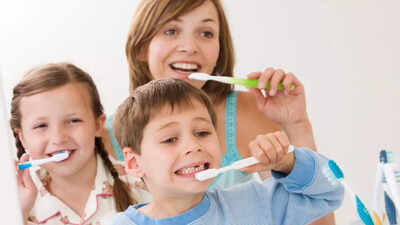Brushing twice a day might actually damage your teeth; know the hidden risks |

Brushing twice a day has long been the hallmark of good oral hygiene. Dentists have promoted it as the best way to prevent decay, keep gums healthy, and maintain a bright smile. However, new research suggests that brushing habits may not be as harmless as they seem. Studies published in the International Dental Journal indicate that frequent or forceful brushing, especially after eating acidic foods, can wear down enamel and irritate the gums. This does not mean brushing should be avoided, but rather that the timing, technique, and toothpaste type may play a far greater role in oral health than how often one brushes.
How brushing can damage enamel and dentine
Enamel, the tough outer layer of the teeth, is built to resist damage, yet it is still susceptible to gradual wear. According to research, the toothbrush alone rarely causes harm. Most modern toothpastes are also mild enough that, when used normally, they do not significantly wear enamel or dentine even over a lifetime. The problem arises when brushing follows soon after consuming acidic foods or drinks such as citrus, coffee, wine, or carbonated beverages. Acids soften enamel for a short period, making it far easier to erode through brushing.The study highlights that repeated brushing under such conditions can lead to long-term enamel thinning and exposure of the dentine beneath. Dentine is softer than enamel, meaning once it is exposed, the rate of wear increases. Although the loss may seem minor, brushing with too much force or frequency over many years can make teeth more prone to sensitivity and visible wear.
Why brushing can be bad for your gums
Gum health is closely linked to brushing habits. Over time, brushing too aggressively or using hard-bristled toothbrushes can cause gums to recede. Gum recession exposes the root surface of teeth, which lacks the same protective enamel covering and is more prone to decay and pain. Researchers found that while tooth brushing is one contributing factor, it is rarely the only one. Anatomical differences, genetic tendencies, and even the shape of individual teeth can influence where and how gum recession develops.Interestingly, electric toothbrushes are no more harmful than manual ones. In some cases, they may be gentler because users apply less force. However, both types can cause damage if used with excessive pressure or an abrasive toothpaste. The key factor is not the brush itself but how it is handled. Gentle, circular movements are less likely to cause trauma than scrubbing side to side, which can scrape gum tissue and enamel simultaneously.
How toothpaste ingredients affect tooth wear
Toothpaste plays a more active role in tooth wear than many people realise. Abrasives are added to remove stains and plaque, but high levels of abrasivity can gradually erode dentine. Modern toothpaste formulations are designed to stay within safe limits, yet overuse can still cause microscopic damage. For example, brushing three or four times a day, or applying heavy pressure while brushing, multiplies the effects of abrasion.The study also found that softer brushes, though gentler on gums, can retain more toothpaste between the bristles and keep it in contact with teeth for longer. This extended contact time can slightly increase surface wear. On the other hand, hard brushes may reduce contact time but pose a higher risk of injuring soft tissues. Therefore, a soft or medium brush used gently for two minutes is considered safest. The toothpaste itself should have a low “Relative Dentine Abrasivity” rating, often indicated on packaging, and should not be marketed solely for whitening.
Brushing and tooth sensitivity : The link beneath the surface
Tooth sensitivity is a common side effect of improper brushing. It occurs when dentine becomes exposed, allowing sensations like heat, cold, or sweetness to travel through tiny tubules to the tooth nerve. Research shows that brushing alone seldom removes enamel, but toothpaste compounds can remove the protective “smear layer” that normally seals these tubules. Once this barrier is stripped away, teeth become more reactive to temperature changes and touch.Certain toothpaste ingredients, particularly sodium lauryl sulphate, are known to open dentinal tubules, increasing sensitivity. However, others, especially those using silica abrasives or non-ionic detergents, can help block them again. This dual nature means the type of toothpaste can either worsen or relieve sensitivity, depending on its formulation. Choosing one designed specifically for sensitive teeth can help rebuild protection without compromising cleanliness.
How to brush without causing harm
The overall evidence is clear: brushing remains essential for oral health, but moderation and technique matter more than force or frequency. Dentists recommend waiting at least half an hour after eating or drinking acidic foods before brushing to allow enamel to re-harden naturally. Using a soft-bristled brush with rounded tips and a gentle, circular motion helps clean effectively without scraping the surface. Two minutes of brushing twice daily, combined with regular flossing and fluoride toothpaste, is sufficient for most people.Researchers emphasise that the benefits of toothbrushing far outweigh the potential risks when done correctly. The real danger arises only from overuse or brushing too soon after acid exposure. Enamel erosion, gum recession, and sensitivity are not the result of brushing itself, but of brushing incorrectly. As one review concluded, it would take more than a hundred years of normal brushing to remove a single millimetre of dentine, proving that healthy brushing is safe when done right.Maintaining good oral health, therefore, is not about brushing harder or longer; it is about brushing smarter.Disclaimer: This article is for informational purposes only and should not be considered medical advice. Please consult a healthcare professional before making any changes to your diet, medication, or lifestyle.Also Read | Sleeping late? Your bedtime might predict a heart attack; here’s what science says












